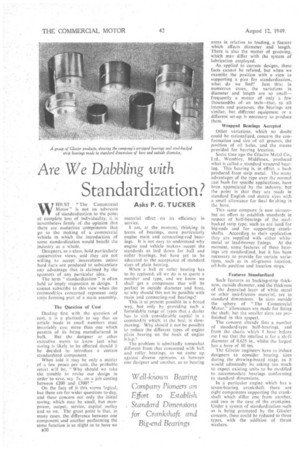Are We Dabbling with
Page 44

If you've noticed an error in this article please click here to report it so we can fix it.
Standardization?
Asks P. G. TUCKER WHILST `-` The Commercial Motor" is not an advocate of standardization to the point of complete loss of individuality, it is nevertheless firmly ,of the ,.opinion that there are .-numerous -components that go to the making of a commercial vehicle in which the introduction of some standardization would -benefit the industry as a whole.
Designers. as a class, hold particularly eonservalive views, and they are not willing. to accept innovations unless hard facts are produced to substantiate any advantage that is claimed by the sponsors of any particular idea.
The term " standardization " is often held .to' imply stagnation in design: I cannot subscribe to this view when the commodi:ies concerned represent only units forming part of 'a main assembly.
The Question of Coat Dealing first with the question of cost, it is a platitude to say that an article made in small numbers must Invariably cost more than one which permits of its • being manufactured in bulk, Hut the designer or other executive wants to know just what saving is likely to be effected should it be decided to introduce a certain standardized component.
When told it may be only a matter of a few pence per unit, the probable retort will be, Why should we take the trouble to revise our design in order to save, say, 5s., on a job costing between /200 and 000? "
On the face of it this seems logical, but there are far wider questions to-day, and these concern not only the initial saving, which may be small, but manpower, output, service, capital outlay and so on, The great point is that, in many cases, the difference between one component and another performing the same function is so slight as to have no SIO Material effect • on its efficiency in service.
• I am, at the moment.,. thinking in terms of .bearings, more particularly engine main and connecting-rod bearings. It is not easy to understand why engine and vehicle makers accept the standards as laid down for ball and roller bearings, but have yet to be eduCatedlo the acceptance of standard sizes of plain bearing.
When a ball or roller bearing has to be replaced, all we do is to quote a number and type, and we know we shall get a component that will be perfect in outside diameter and bore. so why should this not be posTsible with main and connecting-rod bearings?
This is at present possible. in a broad way, but only by providing such a formidable range of types that a dealer has to sink considerable capital in a commodity which, at the best, is slowmoving. Why should it not be possible to reduce the different types of engine plain bearing on the basis of engine .h.h.p.?
The problem is admittedly somewhat different from that concerned with ball and roller bearings, as we come up against diverse opinions, as between one designer and another, as to bearing
areas in relation to loading, a feature which affects diameter and length. There is also the matter of grooving.. which may differ with the system of lubrication employed.
As applied to current designs,, these facts cannot be refuted, but when we examihe the position with a view to supporting a plea for standardization, what do we find? just this: in numerous cases, the variations in diameter' and length are So small— frequently a matter of only a few thousandths of an inch—that, to all intents and purposes, the bearings are similar, but different equipment or a different set-up is necessary to produce them,-.
Wrapped Bearings Accepted
Other variations, which no doubt could he rationalized, concern the conformation and size, of oil grooves, the position of oil holes, and the means • provided for bearing location.
Some time ago the Glacier Metal Co., Ltd., Wembley, Middlesex, produced what is called a standard wrapped bearing. This bearing is, in effect, a bush produced from strip metal. The many advantages of the type over the normal cast bush for specific applications, have been appreciated by the industry. but the point is that they are made in standard English and metric sizes with a small allowance for final fin:shing in the bore.
This same company is now pioneering an effort to establish. standards in respect. of half-bearings of the steel. backed strip type, such as are •'Usecif for big-ends and for supporting . crankshafts. According to their application they are supplied with either white metal or lead-bronze linings. At the moment, Some features of these bearings are standardized, but it has been necessary to provide for certain variations, such as in oil-groove location, oil-hole position and location stops', Features Standardized
Such features as backing-strip thickness, outside diameter, and the thickness of the deposited layer of white metal or other anti-friction material, are to standard dimensions. In sizes outside the sphere of " The Commercial Motor," allowances are made for fitting the shaft, but the smaller sizes are pre-finished in this respect.
The concern already lists a number of standard-type half-hearings. and from the charts which I have before me I see that the smallest is for a shp.ft diameter of 0.625 in., whilst the largest has a bore of 10 ins.
The Glacier engineers have to induce designers to consider hearing sizes during the drawing-board stage, as it would admittedly be asking too much to expect existing units to be modified to accommodate bearings conforming to standard dimensions, In a particular engine which has a seven-bearing crankshaft there are eight components supporting the crankshaft which differ one from another, and two in the case of the crankpins. Under a system of standardization such as is being promoted by the Glacier concern, these could be reduced to three types, with the addition of thrust washers.




















































































